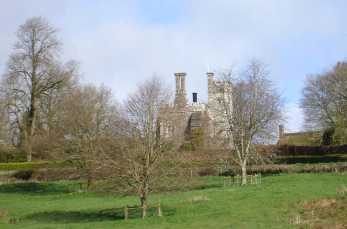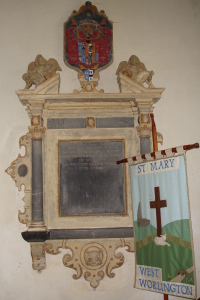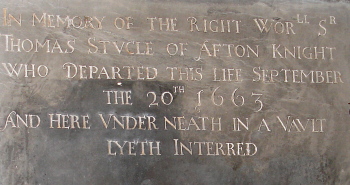
Affeton, to the west of the pretty village of West Worlington in Mid Devon, is one of those isolated spots in the interior of Devon suffused with an aura of timelessness. Affeton Barton, as it is known today, nestles above the northern slope of the valley carved out by the Little Dart River that flows westward past Chulmleigh where it joins the River Taw on its northward journey to the sea.


The road to Affeton from the south crosses the Little Dart at Affeton Mill Bridge. The climb out of the river valley gives way to open grassland to the left, and beyond the park the tall chimneys and stair turret[note 1] of Affeton Castle gatehouse rise high above a thick double hedge. Behind the castle a collection of farm buildings occupy part of the plot where the large fortified mansion once stood.
The manor is listed in the Domesday Book by its former name of Afton; a parish was probably established there in the 13th century, with the de Affeton(or de Afton) family holding sway as feudal lords. The de Affeton line in the parish was superseded by that of Stucley[note 2] around 1434 when Sir Hugh Stucley whose family were from Huntingdonshire married Katherine, the only daughter and heir of Sir John de Affeton. Sir Hugh was created a knight and became High Sheriff of Devonshire in 1448. Exemplifying the tenacity of the aristocratic family in the heartland of rural England, the current owner of the Affeton estate has the same name and held the same position five and a half centuries later in 2006.
Sir Hugh and Katherine were the progenitors of a Devon family that played a prominent part in the affairs of the county and on the national stage for the next two hundred and fifty years.
Affeton has always been a small parish, and was effectively merged with the adjacent parish of West Worlington when in 1437 Edmund Lacy, Bishop of Exeter, gave the rector of West Worlington ministry over its smaller neighbour:
The Affetons and the Stucleys after them occupied the extensive castellated mansion whose reconstructed gatehouse we can see today at what is now known as Affeton Castle.

The grandeur of the estate prior to the Civil War was noted in William White's gazetteer of 1850:
The mansion was built in the shape of an E and surrounded by a moat which has long since dried up. The gatehouse probably dates from the mid fifteenth century. It was converted to a shooting lodge in the 1860s, the central gateway being filled in and the interior redesigned and adapted for residential use. The only original interior features are the stone newel within the 49ft. spiral staircase of the stair turret, and the first floor doorway opening off it.
As in so much of Devon, the peace and tranquillity of Affeton was shattered during the Civil War. The Royalist sympathies of the mansion's incumbent Sir Thomas Stucley were known to General Fairfax, and in 1646, on route from Crediton via Chulmleigh to challenge the King's men at Torrington, a small detachment of Fairfax's Parliamentary army was sent on the short detour to Affeton to raze the mansion and the church which had become the Stucley chapel.
Family loyalties were often divided during the Civil War, the Stucleys being no exception, and Thomas's brother Lewis was chaplain to Oliver Cromwell until the monarchy was restored. This disunity may lie behind the targeting of the Stucley mansion by Royalist forces on two earlier occasions.
Thomas was most likely within the walls of Exeter which was under siege at the time, but Lady Stucley must have been forewarned of the imminent assault. She had time to conceal her valuables along with her servants and cattle in the prehistoric settlement in Burridge Wood [note 3]; these days the only inhabitants are the sheep. This settlement is shown on the map to the south-west of Affeton, on the opposite side of the river.


Thomas's troubles did not end with the Parliamentarian victory. Later in 1646 he was hauled before the Commissioners in Exeter to account for his support of the King during the hostilities. He told them that his Affeton house had been plundered several times during the war, and he was now financially ruined. This plea fell on deaf ears and he was fined £300 for aiding the Royalist cause. To pay off his debts Thomas was obliged to sell half the Affeton Barton farmlands on a 99 year lease.


The decorative plaque shown above hangs on the north wall of the chancel in the Church of St Mary in nearby West Worlington. The inscription engraved on slate commemorates Sir Thomas who was buried in a vault beneath the church.
A farm house or barton (in the Devon vernacular) was built over the foundations of the sacked manor house, using stones from the ruins. The property passed to the descendants of Sir Thomas's niece, Sarah, who married into the Bucks, a wealthy family of merchants from Bideford. They divided their time between Affeton and their larger family seat of Hartland Abbey on the North Devon coast.
George Stucley Buck who was the great grandfather of the present owner, Sir Hugh Stucley the 6th Baronet, had a distinguished political career as Member of Parliament for Barnstaple. As lineal representative of the ancient Stucley family, he was given permission to change his name from Buck to Stucley by Queen Victoria in 1858 as part of a Grant of Arms proclamation:
He was awarded the hereditary title of baronet the following year.


The most colourful of the Stucleys raised in the family seat of Affeton was Captain Thomas Stucley, that notorious swashbuckler of the Elizabethan age.
The third son of yet another Sir Hugh Stucley of Affeton, a wealthy clothier who was sheriff of Devon in 1544, he was born around 1520 to Jane Pollard daughter of Sir Lewis Pollard, though it was claimed during his lifetime that Thomas was an illegitimate son of Henry VIII.
A cohort of royalty and popes, his remarkable life included many adventures on the high seas as a mercenary and a pirate. He was also an arch manipulator and intriguer, acting as political advisor and diplomat to his Catholic friends and traitor to others, most notably Queen Elizabeth I of England who described him as 'a faithless beast rather than a man'.
Thomas was widely portrayed in dramas and poetry after his heroic death in the Battle of Alcazar.
The story of how Sir Lewis Stucley was encouraged to betray Sir Walter Raleigh on his return from Guiana by the unscrupulous King James I is the subject of this Devon Villains feature.


Follow the road along the ridge from Affeton to the east for a mile or so and you reach West Worlington, with its neat thatched cottages rendered in various pastel hues nestling closely together at the top of a steep hill. As the road bends to the right a set of shallow cobbled steps take you to an archway through Church House into the churchyard of St Mary's.
The church has an attractive twisted spire built on top of a low tower dating from the late 13th century that may have been rebuilt in the 17th century. Close examination shows the spire to be constructed of wooden shingles.



Inside the church an ornate screen of late Perpendicular Gothic style from about 1500 encloses the chapel in the south aisle. Beyond the entrance to the church the narrow road descends steeply between more thatched cottages.

